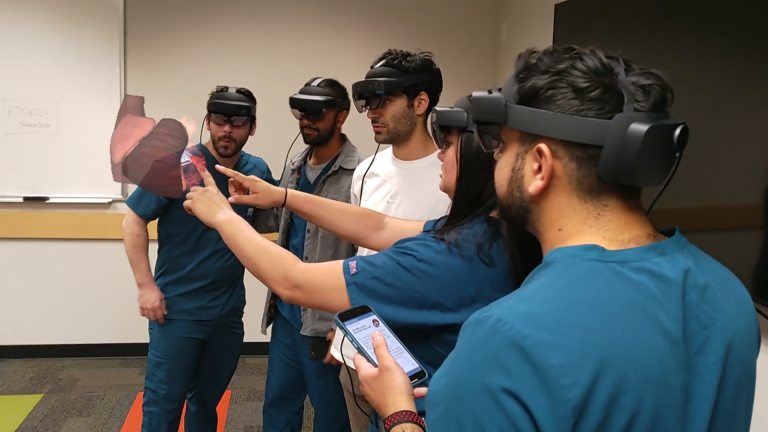A.T. Still University Ignites Human Anatomy Student Engagement with HoloAnatomy®
ATSU School of Osteopathic Medicine in Arizona
Founded in 1892 as the world's first osteopathic medical school, A.T. Still University (ATSU) has consistently prioritized innovative learning to cultivate highly skilled professionals. The School of Osteopathic Medicine in Arizona (SOMA) exemplifies this commitment, embracing revolutionary teaching techniques to prepare the next generation of osteopathic physicians. Their pursuit of an interactive, collaborative approach to human anatomy and central nervous system education culminated in adopting the HoloAnatomy® learning platform.
AlensiaXR sat down with Anna Campbell, Ph.D. (Associate Professor, Chair, Anatomy Department, SOMA) and John Olson, Ph.D. (Anatomy Professor, SOMA) to explore how they revolutionized anatomy instruction at SOMA.
AlensiaXR: Describe your initial experience of HoloAnatomy software—what stood out for you?
Anna Campbell, Ph.D., Associate Professor, Chair, Anatomy Department
We have a traditional wet lab, and we’ve tried different solutions for displaying anatomical structures. The missing piece for me was always that I wanted students to be able to move around the anatomy—to be able to see smaller structures in a holographic model and move around the body as you would move around a patient. For me, that was a very compelling piece of the HoloAnatomy offering. Also, the anatomical accuracy and level of detail checked a lot of boxes for choosing which new technology to bring to ATSU.
AlensiaXR: What was the HoloAnatomy classroom experience like?
Anna Campbell:
It brought back an excitement we can all relate to—that first-day-of-school excitement, that kind of fluttery feeling in your chest when you're excited to embark on a new adventure. When students first experience HoloAnatomy, you can feel the electricity in the room as they're buzzing and talking to each other, whipping out their phones because they want to share the experience. It’s fun and joyful, and that's what I want for my students. They're going to look back and say, ”That was one of the best times of my life.” And professors feed off those feelings of excitement.
ATSU-SOMA students use HoloAnatomy to study anatomical structures. (Courtesy of ATSU-SOMA)
AlensiaXR: Have you seen student engagement increase as a result of incorporating HoloAnatomy in your curricula?
Anna Campbell:
Absolutely. And that's something I point out to other faculty at our institution. One of the most exciting parts of implementing this technology has been to observe student engagement increase. They're drawn in because they're working collaboratively to explore these models. They gather around the model and interact with each other, sharing points of discussion and discovery as they learn to apply foundational knowledge to clinical scenarios. It brings me a lot of joy as an instructor to observe because I know the value that brings in terms of the learning experience—the more engaged your learner is, there's lots of evidence that the result is meaningful for learning outcomes. So, we're paying attention to that engagement and actively finding ways to foster it as students use this technology throughout their experience here.
John Olson:
When students are working with cadavers—which are the gold standard for anatomy—there’s still a significant number of limitations and some students feel some reluctance about interacting with the specimens. But when you see them interacting with a HoloAnatomy model, they're laughing and talking with each other. It's much more lighthearted, and they're much more involved.
AlensiaXR: Can you describe the role HoloAnatomy has played in developing your students’ understanding of human anatomy?
Anna Campbell:
In a way, HoloAnatomy is like the Google Maps of the human body that allows you to get the lay of the land in a meaningful way. You have a mental map. It helps if you understand the branching of the arteries and nerves before you try to sort those out on a cadaver. For us, it's an essential step in the learning process. They have these Eureka! moments when they see the material we’re studying in three dimensions. They develop a stronger understanding of what they're looking for in the wet lab environment because they've had the HoloAnatomy experience. They see how these structures connect to each other, so it's been a very effective tool for our students. They often return to HoloAnatomy to reformulate what they saw in the lab. Students want to see clearly and better understand.
“HoloAnatomy is like the Google Maps of the human body”
AlensiaXR: Which HoloAnatomy elements do your students find most engaging?
John Olson:
When they interact with the model and get a three-dimensional view of what's going on. [Unlike in the cadaver lab], they don't have to physically work really hard to peel the layers of muscles off or try to move a heavy cadaver around. It's much easier for them to interact with a holographic model than a plastic model or cadaver if you want to investigate something specific.
AlensiaXR: When you introduced HoloAnatomy to your students, what was the feeling in the room?
Anna Campbell:
We feed off students’ excitement, and they were just oohing and ahhing. We had described HoloAnatomy to students. Of course, it’s not the same as putting the device on your head for the first time and seeing the models pop up in the room and being able to walk around them. We have this new space where we run lab sessions, a big open room with glass doors, and people walking by could witness the excitement of our students. It's a lot of fun. Our Dean came in and walked around and got to experience it. The HoloAnatomy experience creates a lot of joy and excitement at ATSU.
Download the HoloAnatomy eBook
Learn about its origin, transformative growth, and invaluable benefits experienced by a growing list of institutions and organizations.




